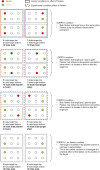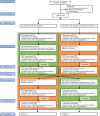Stereoptic serious games as a visual rehabilitation tool for individuals with a residual amblyopia (AMBER trial): a protocol for a crossover randomized controlled trial
- PMID: 37198558
- PMCID: PMC10190050
- DOI: 10.1186/s12886-023-02944-y
Stereoptic serious games as a visual rehabilitation tool for individuals with a residual amblyopia (AMBER trial): a protocol for a crossover randomized controlled trial
Abstract
Background: Amblyopia is the most common developmental vision disorder in children. The initial treatment consists of refractive correction. When insufficient, occlusion therapy may further improve visual acuity. However, the challenges and compliance issues associated with occlusion therapy may result in treatment failure and residual amblyopia. Virtual reality (VR) games developed to improve visual function have shown positive preliminary results. The aim of this study is to determine the efficacy of these games to improve vision, attention, and motor skills in patients with residual amblyopia and identify brain-related changes. We hypothesize that a VR-based training with the suggested ingredients (3D cues and rich feedback), combined with increasing the difficulty level and the use of various games in a home-based environment is crucial for treatment efficacy of vision recovery, and may be particularly effective in children.
Methods: The AMBER study is a randomized, cross-over, controlled trial designed to assess the effect of binocular stimulation (VR-based stereoptic serious games) in individuals with residual amblyopia (n = 30, 6-35 years of age), compared to refractive correction on vision, selective attention and motor control skills. Additionally, they will be compared to a control group of age-matched healthy individuals (n = 30) to account for the unique benefit of VR-based serious games. All participants will play serious games 30 min per day, 5 days per week, for 8 weeks. The games are delivered with the Vivid Vision Home software. The amblyopic cohort will receive both treatments in a randomized order according to the type of amblyopia, while the control group will only receive the VR-based stereoscopic serious games. The primary outcome is visual acuity in the amblyopic eye. Secondary outcomes include stereoacuity, functional vision, cortical visual responses, selective attention, and motor control. The outcomes will be measured before and after each treatment with 8-week follow-up.
Discussion: The VR-based games used in this study have been conceived to deliver binocular visual stimulation tailored to the individual visual needs of the patient, which will potentially result in improved basic and functional vision skills as well as visual attention and motor control skills.
Trial registration: This protocol is registered on ClinicalTrials.gov (identifier: NCT05114252) and in the Swiss National Clinical Trials Portal (identifier: SNCTP000005024).
Keywords: Amblyopia; Binocular stimulation; Child; Dichoptic stimulation; Electroencephalography; Kinematics; Motor control; Optical treatment; Refractive correction; Stereovision; Virtual reality; Visual attention.
© 2023. The Author(s).
Conflict of interest statement
James Blaha is the CEO and founder of Vivid Vision Inc. Ben Backus is the Chief Science Officer of Vivid Vision Inc. Brian Dornbos is the Chief Operations Officer of Vivid Vision Inc. Vivid Vision Inc. freely provided the licenses to use Vivid Vision Home for the study. Vivid Vision Inc. does not have the ultimate authority on the design, intervention or publication of this study. The other authors declare that they have no competing interests.
Figures




